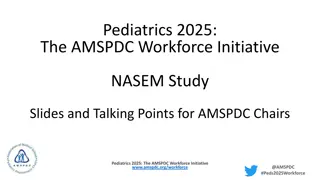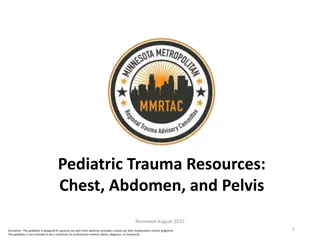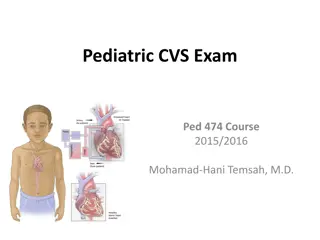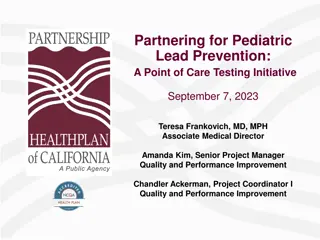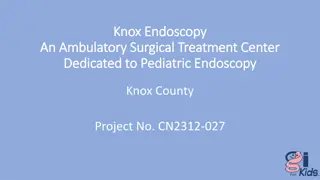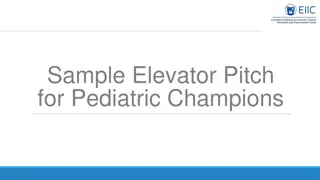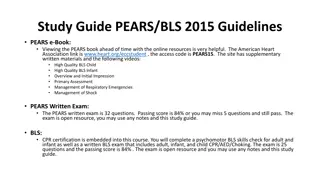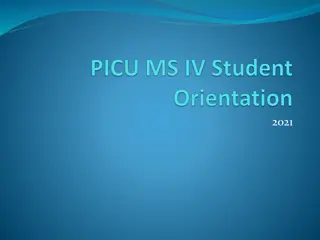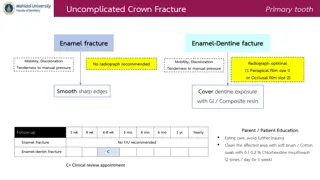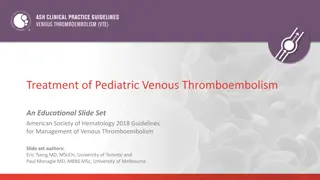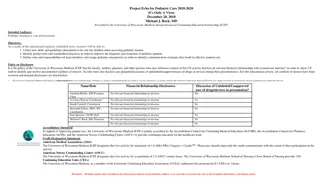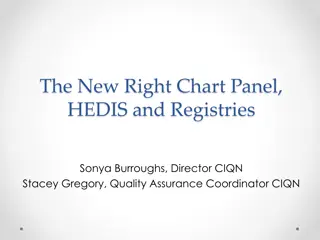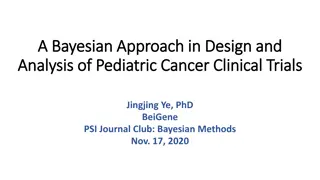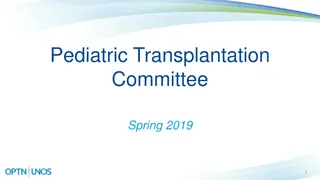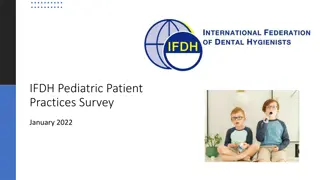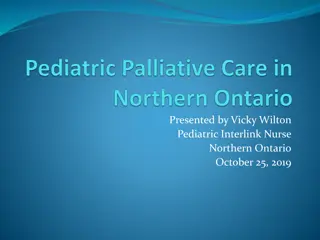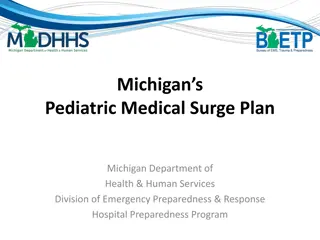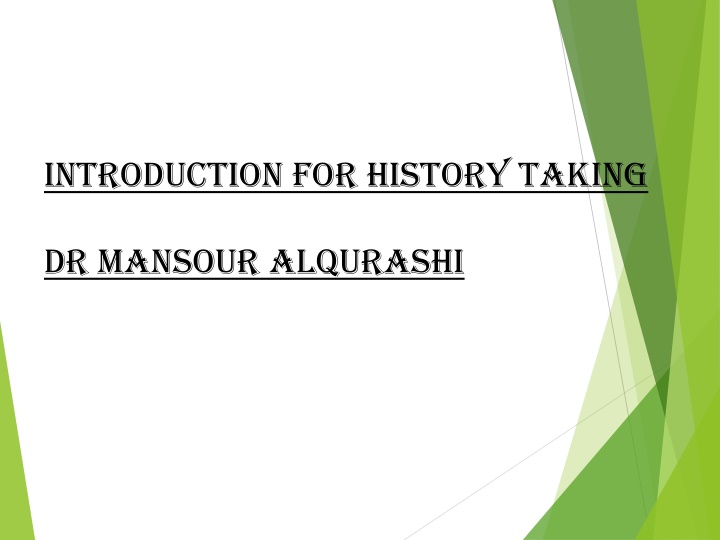
Pediatric History Taking Essentials by Dr. Mansour Alqurashi
Explore the key objectives and techniques for obtaining a comprehensive medical history in pediatric patients, emphasizing the differences between adult and child history taking. Learn the importance of parental involvement, effective questioning strategies, and essential elements to gather a detailed history. Gain insights into the approach, items, and chief complaints in pediatric history taking.
Download Presentation

Please find below an Image/Link to download the presentation.
The content on the website is provided AS IS for your information and personal use only. It may not be sold, licensed, or shared on other websites without obtaining consent from the author. If you encounter any issues during the download, it is possible that the publisher has removed the file from their server.
You are allowed to download the files provided on this website for personal or commercial use, subject to the condition that they are used lawfully. All files are the property of their respective owners.
The content on the website is provided AS IS for your information and personal use only. It may not be sold, licensed, or shared on other websites without obtaining consent from the author.
E N D
Presentation Transcript
Introduction FOR history taking DR MANSOUR ALQURASHI
Pediatric History Learning Objectives: 1.To understand the differences in obtaining a medical history on a pediatric patient compared to an adult. 2.To understand all the ramifications of the parent as historian in obtaining medical history in pediatric patient. 3.To understand the appropriate wording of open-ended and directed questions ,and appropriate use of each type of question . 4.To obtain an accurate and complete history of pediatric patient in different age groups. (<1, 1-5 y., >5y).
Pediatrics BDefinition: ranch of medicine that Branch of medicine that deals with medical care of children.*. (Birth till 18 yeas of age ). (deals with medical care of children Branch of medicine that deals with medical care
Approach Introduce yourself to patient s companion (usually the mother). Get the respect of the mother in order to get the confidence of the child.
Items of Pediatrics History Date of history. Name of patient. Informant :- Mother, father, grandmother, school teacher, .. Reliability:- Good, fair, poor. History taken by :- Your name and title. Patient s profile:- Age (including date of birth) Sex Address (usually name of city, town or village). Referred from . Significant medical conditions. 1. 2. 3. 4. 5. 6.
Items of Pediatrics History 7. Chief complaints (Presenting Complain) :- Who is concerned (pt., mother, school teacher...)? When did you notice that your child has changed? OR what he is complaining of? OR what do you think he is sick with? Use, when possible, patient s or patient s mother own words. Arrange complaints according to significance to child health. Onset / Course/ Duration of each complaint.
Items of Pediatrics History The main problem or complaints for which the child has been brought for medical attention: Fever 5 days. Vomiting 4 days. DIARRHEA. ABDOMINAL PAIN. COUGH. HEADACHE.
Items of Pediatrics History 8. History of present illness:- Start with one of the following sentences:- The patient was doing well until .. The history of this child dates back to .. The patient was in his usual state of health until .. Analysis of symptoms respecting the chronological order of symptoms. Sequence of events. Other associated symptoms. Important negative symptoms related to the complaints.
Items of Pediatrics History History of Present illness Progress of disease ; order and date of onset of new symptoms. Aggravating and alleviating factors. Significant medical attention and medications given and over what period. In acute infection ,statement of type and degree of exposure and interval since exposure.
Outline of Specific Pediatric History Items A. Antenatal B. Perinatal: C. Neonatal : D. Growth , development and behavior. E. Nutrition F. Past illnesses G. Immunizations H. Allergies and test. reactions. I. Accidents and Injuries.
Antenatal Antenatal care: - booked/ un- booked? , where? frequency of visits. Prenatal exposure to illicit drugs, toxins, or infections; maternal diabetes; acute maternal illness; trauma; radiation exposure and fetal movements.(The prenatal period refers to the period of time from fertilization to birth.) Medications during pregnancy (timing/dose/duration) Maternal thyroid or seizure disorder. Polyhydramnios/ Oligohydramnios. Maternal severe proteinuria or high blood pressure. Bleeding in third trimester. Multiple gestation. Chorioamnionitis.
Perinatal History Perinatal period: 22 completed weeks of gestation and ends 7 completed days after birth. Place of delivery. Presentation of the child( e.g breech or face presentation) Mode of delivery: - NSVD, assisted vaginal, C/S. Obstetrical complications Gestational age. Birth weight and other birth measurements (Lt, HC) Resuscitation Apgar Score or condition at birth in mother s words. Maternal risk factors for sepsis (PROM, maternal UTI, maternal fever ) Baby & mother s blood groups.
NEONATAL When the baby passed urine/ meconium? Respiratory distress, anemia, jaundice, cyanosis, convulsions, infection, congenital anomalies If he/she was admitted in hospital : Length of hospital stay. Complications (eg, intubation time, presence of intracranial hemorrhage ultrasonogram, feeding difficulties, apnea, bradycardia.
Developmental History Growth is increase in the size of the organ. Development is increase in the function of the organ. Ask about physical growth (Wt., Ht, HC) especially if records available. Developmental milestones. Gross Motor Fine Motor Social/Adaptive Language/Speech Age at attainment of important milestones (walking, talking, self- care) Relationships with siblings, peers, adults School grade and performance behavioral problems (Sleep disturbance , phobias, Pica, Abnormal bowel habits ,stool holding, Bed wetting and Unusual behavior)
Nutrition Breast feeding or milk formula. Type and amount of semi solid/ solid foods, & when added. Any vitamin or iron supplementation. Difficulty encountered during feeding ,eg NGT feeding. Any known food allergy. Type of diet change in feeding habits.
Past medical history Infections:age,types, number,severity. Contagious diseases;age ,complication. Past hospitalizations. operations age. Allergies : to drugs or food ,type of reaction. Medications patient is currently taking.(Names,dosages). Accidents and Injuries.
Immunizations Place of vaccination What schedule . Additional vaccines Always ask for vaccination card.(Up-to-date ?! ) Any vaccine side effects. It is important to record the details of vaccines given to the child in chronological order.
Family History A. Father and mother (age and health) B.Marital relationship/ consanguinity pattern C.Siblings. Age,health,significant illnesses.(The pedigree chart). D.Birth of abnormal children( e.g LBW.IUGR,Dysmorphic, with a motor deficit, mental retardation, or Congenital malformations). E. Stillbirth,miscarriages,age of death and cause of death. F. TB.allergy,blood dis.,mental or CNS.,diabetes,cvs,kidney dis., ..ect. G. Health of contacts.
Social History Address, home condition (sunny, ventilation, rooms ) Health insurance. Parental education & occupation. Family income & socioeconomic status and allowances. Smoking at home. alcohol and drugs. Who is taking care of child in the home? Impact of the disease on the child, siblings ,father and mother. Safety: Child car seats, smoke detectors, bicycle helmets.
Adolescent history [ HEADS history] Home Education Activities Drugs. Sexual activity.(53)
Review of Systems General : Overall health. Weight loss. Behavioral changes. Fever. Fatigue.
Review of Systems Skin: Rashes/bruising. Lumps/bumps. Nail/hair changes. Eyes: Visual problems Eye pain. Ear, nose, throat: Frequency of colds. Sore throat. Earache.
Review of Systems Lungs: Cough shortness of breath Wheezing Cardiovascular: Chest pain/Palpitation. Exercise intolerance . Syncope.
Review of Systems Gastrointestinal: Nausea/vomiting Spitting up Diarrhea Recurrent abdominal pain Constipation Blood in stools.
Review of Systems Genitourinary: Dysuria Hematuria Polyuria Vaginal discharge
Review of Systems Musculoskeletal: Weakness Joint pain Gait abnormalities Scoliosis Neurological: Headache Seizures
Review of Systems Endocrine: Growth delay Polyphagia (Extreme, insatiable hunger) Polydipsia (Excessive thirst/fluid intake) Menses duration/ Amount of flow
Pediatric History compered to an adult History I. Content Differences ; A. Prenatal and birth history. B. Developmental history C. Social history of family environmental risks D. Immunization history II.Parent as Historian A. Parent s interpretation of signs ,symptoms. 1.children above the age 4 may be able to provide some of their own history. 2.Reliability of parent's observations varies. 3.Adjust wording of questions varies. (pain vs .limping)
Continue history differences B. Observation of parent-child interactions 1.Distraction to parents may interfere with history taking . 2.Quality of relationship . C. Parental behaviors /emotions are important. 1.Parental guilt nonjudgmental/reassurance 2.The irate parent ; causes 2.

